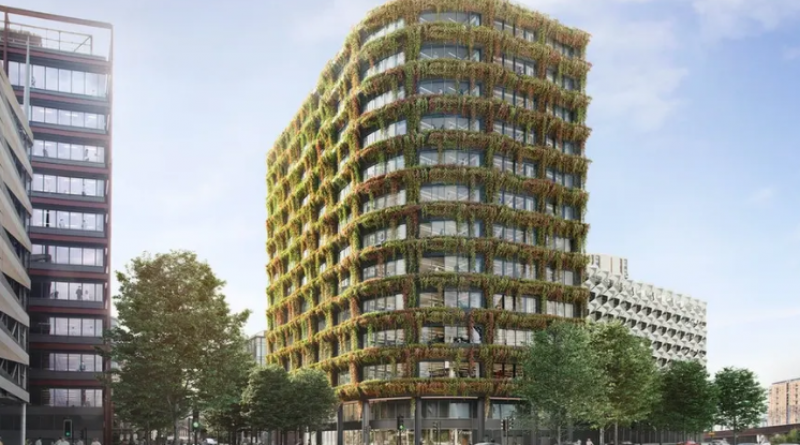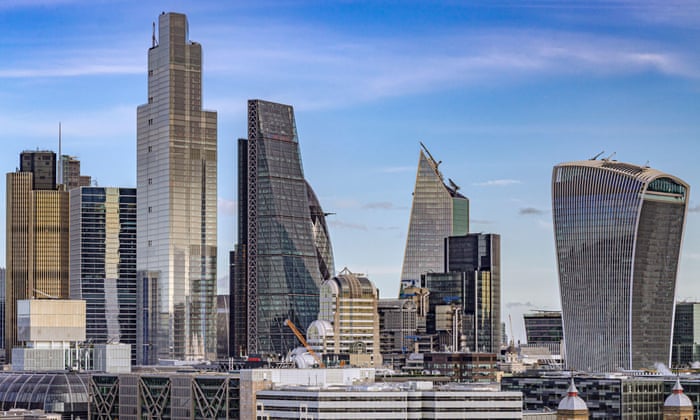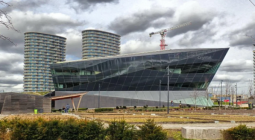The dirty secret of so-called 'fossil-fuel free' buildings

The ‘embodied carbon’ in the building of glass and steel blocks makes them anything but green
Hanging plants smother the walls of a new office block proposed for Salford, giving it the look of something from an abandoned post-Covid city, reclaimed by nature. The ivy-covered tower, designed by Make Architects, has been trumpeted as “fossil-fuel free”, set to run on 100% renewable energy and reach net zero operational carbon, with tenants enjoying the “biophilic” benefits of dangling foliage. But not everyone is convinced.
“It’s strange to see something described as ‘fossil-fuel free’ when it is made of concrete, steel and glass,” says Joe Giddings, coordinator of the Architects Climate Action Network (Acan) campaign group. “The production of these materials entails burning a huge amount of fossil fuel.
“The climate emergency is not a game and we can’t just spin our way through it. We need to think about where our materials come from, how they’re made and interrogate the whole supply chain – from construction to demolition and reuse.”
In the race to reach net zero carbon by 2050, a commitment to which the UK is legally bound, Acan sees the biggest unchallenged obstacle as the energy consumed by construction. Much is made of the proposed energy efficiency of buildings once they are occupied, but so far very little attention has been paid to the carbon emitted in getting them built, and eventually dismantled – from extracting raw materials and manufacturing components, to the toxic byproducts of demolition leaking out in landfill.
Acan estimates that this “embodied carbon” accounts for up to three-quarters of a building’s total emissions over its lifespan, a proportion that is only going to grow as the energy grid becomes increasingly decarbonised with the rise of renewables. With the built environment contributing about 45% of the total carbon emitted in the UK, the embodied energy of construction has become the vital element to focus on.
“Government regulation is really lagging behind,” says the architect Simon Sturgis, founder of carbon consultancy Targeting Zero. “Over the next 60 to 70 years the most immediate problem will be construction emissions, and it’s something that is not even considered by the building regulations at the moment.
“It is quite straightforward to address: very significant carbon reductions can be made for very little cost.”

Sturgis recently co-authored a section of the new London Plan, which mandates a “whole life-cycle carbon” assessment for new developments for the first time – a policy used in the Netherlands since 2013. No targets have been set, but developers of big schemes referred to the mayor will now have to calculate the projected emissions of their proposals over their entire lifespan, including construction, demolition and disposal, and show how they have tried to reduce the carbon consumption.
“It’s about choosing things slightly more carefully,” says Sturgis. “Using less concrete and more timber, or specifying recycled aluminium for window frames.
“It’s also crucial to understand the relationship between improving operational emissions and the carbon costs of doing so. Triple-glazed windows might reduce heating requirements, but their embodied carbon is vast.”
He is highly critical of glass-walled office towers, arguing that, while they may boast environmental credentials, they have a huge amount of built-in obsolescence, given that their glazing systems are often only guaranteed to last for 30 years. You would expect these towers to last at least a century,” he says, “but they have a big embodied cost when these deep, triple-glazed units will have to be replaced so often.”
As it stands, there is no incentive for manufacturers to make their components last longer.
Despite the lack of regulation, there is a growing consensus in the industry that more has to be done. The major professional bodies – including the Royal Institution of Chartered Surveyors, the Royal Institute of British Architects, the Institution of Structural Engineers and the Chartered Institution of Building Services Engineers – have all provided guidance on embodied carbon assessment, and called on the government to intervene.

The environmental engineer Clara Bagenal George recently produced a guidance document for assessing the embodied carbon of building services equipment (including heating, lighting, plumbing, etc), a crucial part of the jigsaw that has largely been ignored until now.
“When you do a retrofit project, the services equipment can represent 80% of the embodied carbon,” she says. “It’s the hidden element, which often needs upgrading over time.”
Building services and plants typically use a high proportion of steel, aluminium, plastics and copper in their construction, as well as rare earth elements for key components, such as permanent magnets in motors and phosphors for lamps. Solar panels, for examples, often contain lead, cadmium and other toxic chemicals that cannot be removed without breaking apart the entire panel, while there are difficulties in recycling the glass due to impurities.
The International Renewable Energy Agency estimated there was about 250,000 tonnes of solar panel waste in the world in 2016, and has projected the amount could reach 78m tonnes by 2050. Insulation is another testy topic. The most efficient, foamed plastic type of insulation is also the most polluting, with as much as a tenfold difference in embodied carbon between synthetic and natural alternatives, says Sturgis.
In the absence of national policy, it seems hard-nosed financial incentives are encouraging developers to act. With the increased prevalence of green finance options, and conditions recommended by the Taskforce on Climate-related Financial Disclosures, proof of a climate-conscious approach is becoming necessary to secure certain sources of funding.
British Land, developer of the Leadenall Building (the “cheese grater” tower) in the City of London, recently introduced an internal levy on its carbon emissions, essentially taxing the carbon of its own projects to create a fund that is used to retrofit its existing building stock. It has also linked its employees’ annual bonuses to the embodied carbon figures, which has already resulted in a preference for refurbishment over demolition.
The government’s new future homes standard makes no mention of embodied carbon, but there is a growing group of MPs calling for change. Last week, the environmental audit committee launched an inquiry focused specifically on the carbon footprint of construction and the sustainability of the materials used. It follows on from a report last month in which the committee recommended introducing embodied carbon targets for the construction of new homes, so as to increase demand for low-carbon materials.
It also recommended cutting VAT on refurbishment, which has long been urged by the industry, as it is often the deciding factor in whether to demolish or retrofit: at present, new builds are VAT-exempt but renovations are not.
“One positive of the pandemic is that it has made people realise that rapid change is possible, and often desirable,” says Sturgis. “Government departments are all scrambling to find out more about zero carbon. It seems that Boris Johnson has realised that Joe Biden is all over the climate agenda, so he’d better get all over it too.”
3 April 2021
The Guardian




